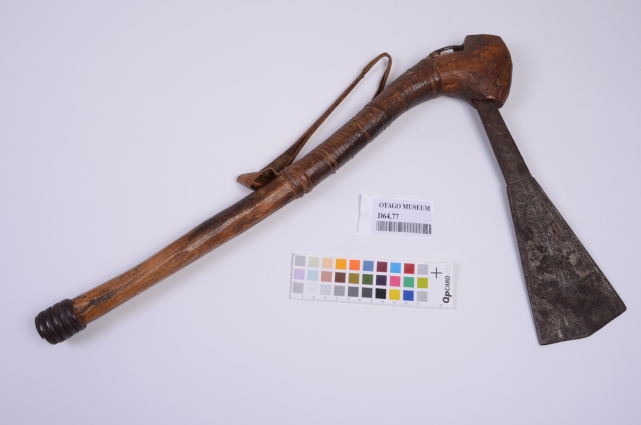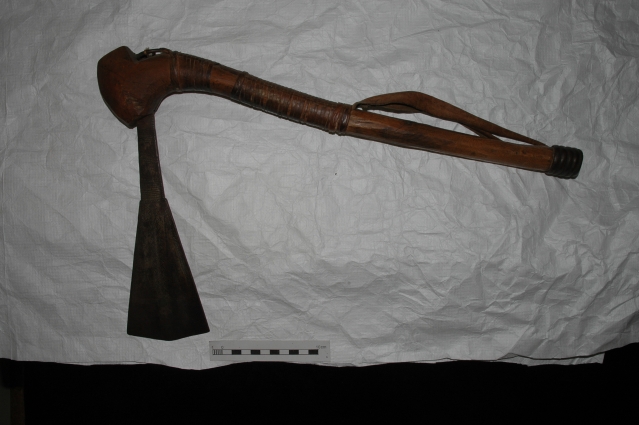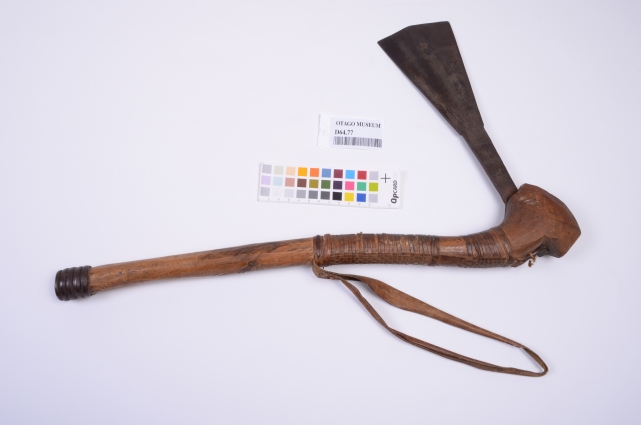Axe, D64.77
Physical Description
Axe: Wooden handle axe with flat hand forged cutting blade. Shape of the wooden handle is that of a gentle S', not unlike that of a cobra in a defensive posture. The wooden handle has a slight taper from its rather heavy, club shaped head, to its more slender round base, i.e. near the hand hold portion. The club head appears to have been the base of a branch where it angled off the main trunk or branch - keeping a portion of the main trunk/branch. The iron head is a hand forged flat blade shaped tapering from a wide cutting blade end to a much narrower tang. The tang end has been inserted through the club end of the wooden handle and protrudes from the opposite side. Through a hole in the end of the tang a iron ring has been inserted effectively preventing the blade being dislodged from the handle. The blade has very similar decorations on both sides. A series of vertical parallel lines run from edge to edge on the tang end of the blade. Where the tang flares to the main body of the blade, and on the blade, are a series of cross hatches cut into the iron forming roughly two identical triangles placed back to back with the second sides running along the edges of the blade. From approx. half way up the handle a series of leather straps have been wrapped around the handle and woven together on the handle's back side. This weaving runs up the handle to just below the head where the leather straps are tightly wound around approx. a quarter of the circumference of the iron 'locking' ring, effectively tying the ring closely to the back of the handle. At the lower end of this leather strapping - i.e. about half way up the handle a wider leather strap has been tied into the handle while also being tied back on itself forming a holding strap. The base of the handle is tightly bound by a iron coil of 6 spirals. The colour of the wood and leather is of a dark natural brown. The colour of the iron blade and coil is of a naturally aged dark brown to black. The general appearance is of an object having received frequent handling - a strong patina of human handling covers much of wood and leather. The appearance if of an object much handled and in good condition.
Research Notes
Original documentation says "Nigeria". Axes of similar types are found throughout much of sub_Saharan Africa. It is reasonable to assume that this axe is from Nigeria, but its exact source/location/cultural group is not known.
Likely as a symbol of prestige/authority. Its highly decorative features, e.g. incised decorations on blade would suggest less likely to be used as weapon or for cutting wood. Axe: Wooden handle axe with flat hand forged cutting blade. Shape of the wooden handle is that of a gentle S', not unlike that of a cobra in a defensive posture. The wooden handle has a slight taper from its rather heavy, club shaped head, to its more slender round base, i.e. near the hand hold portion. The club head appears to have been the base of a branch where it angled off the main trunk or branch - keeping a portion of the main trunk/branch. The iron head is a hand forged flat blade shaped tapering from a wide cutting blade end to a much narrower tang. The tang end has been inserted through the club end of the wooden handle and protrudes from the opposite side. Through a hole in the end of the tang a iron ring has been inserted effectively preventing the blade being dislodged from the handle. The blade has very similar decorations on both sides. A series of vertical parallel lines run from edge to edge on the tang end of the blade. Where the tang flares to the main body of the blade, and on the blade, are a series of cross hatches cut into the iron forming roughly two identical triangles placed back to back with the second sides running along the edges of the blade. From approx. half way up the handle a series of leather straps have been wrapped around the handle and woven together on the handle's back side. This weaving runs up the handle to just below the head where the leather straps are tightly wound around approx. a quarter of the circumference of the iron 'locking' ring, effectively tying the ring closely to the back of the handle. At the lower end of this leather strapping - i.e. about half way up the handle a wider leather strap has been tied into the handle while also being tied back on itself forming a holding strap. The base of the handle is tightly bound by a iron coil of 6 spirals. The colour of the wood and leather is of a dark natural brown. The colour of the iron blade and coil is of a naturally aged dark brown to black. The general appearance is of an object having received frequent handling - a strong patina of human handling covers much of wood and leather. The appearance if of an object much handled and in good condition.
Length of handle is approx. 495mm (from tip of head to base of handle). The diameter just above the iron coil near its base is approx. 251 mm. The length of iron blade is approx. 300 mm. The thickness of iron blade where tang flares to main blade = approx.6.7 mm. —Joel A Vanderburg
Likely as a symbol of prestige/authority. Its highly decorative features, e.g. incised decorations on blade would suggest less likely to be used as weapon or for cutting wood. Axe: Wooden handle axe with flat hand forged cutting blade. Shape of the wooden handle is that of a gentle S', not unlike that of a cobra in a defensive posture. The wooden handle has a slight taper from its rather heavy, club shaped head, to its more slender round base, i.e. near the hand hold portion. The club head appears to have been the base of a branch where it angled off the main trunk or branch - keeping a portion of the main trunk/branch. The iron head is a hand forged flat blade shaped tapering from a wide cutting blade end to a much narrower tang. The tang end has been inserted through the club end of the wooden handle and protrudes from the opposite side. Through a hole in the end of the tang a iron ring has been inserted effectively preventing the blade being dislodged from the handle. The blade has very similar decorations on both sides. A series of vertical parallel lines run from edge to edge on the tang end of the blade. Where the tang flares to the main body of the blade, and on the blade, are a series of cross hatches cut into the iron forming roughly two identical triangles placed back to back with the second sides running along the edges of the blade. From approx. half way up the handle a series of leather straps have been wrapped around the handle and woven together on the handle's back side. This weaving runs up the handle to just below the head where the leather straps are tightly wound around approx. a quarter of the circumference of the iron 'locking' ring, effectively tying the ring closely to the back of the handle. At the lower end of this leather strapping - i.e. about half way up the handle a wider leather strap has been tied into the handle while also being tied back on itself forming a holding strap. The base of the handle is tightly bound by a iron coil of 6 spirals. The colour of the wood and leather is of a dark natural brown. The colour of the iron blade and coil is of a naturally aged dark brown to black. The general appearance is of an object having received frequent handling - a strong patina of human handling covers much of wood and leather. The appearance if of an object much handled and in good condition.
Length of handle is approx. 495mm (from tip of head to base of handle). The diameter just above the iron coil near its base is approx. 251 mm. The length of iron blade is approx. 300 mm. The thickness of iron blade where tang flares to main blade = approx.6.7 mm. —Joel A Vanderburg
Provenance
Locality:
Nigeria
Measurements
Maximum dimensions (H x W x D): 500 x 305 x 41mmAll Rights Reserved








